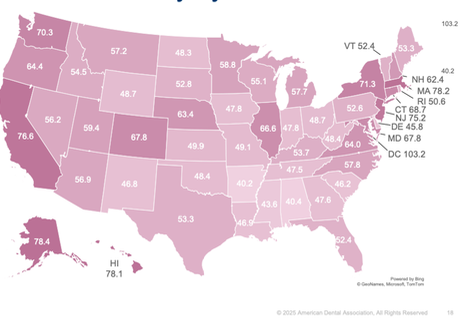State of Dentistry in 2025
The New Technology
This year Technology has blown up the dental industry. AI is taking over and it’s not only changing the face of the world but it is also affecting change in dentistry as well. Cloud management software, AI scanners, automated patient engagement, and more…
The Demand for Dentistry
The demand for dentistry is continuing to grow. ADA releases a report every year about the state of practice ownership across the United States, including the demand for dentistry along with number of graduates year over year.
The patient to dentists ratio peaked at 61.1 (100,000 population ratio) in 2017 and has slightly declined since then. The chart notes that this decline “reflects the temporary retirement surge occurring.” This indicates that while the overall trend is stable, there are periods where the number of dentists entering the workforce hasn’t quite kept up with those leaving, creating a slight dip in the ratio.

Of course this is an average and varies from state to state and location to location. In general there are smaller ratios in the largely urban areas. The rural ratio is significantly lower, hovering around the 30’s. It was 33.8 in 2001 and has slightly decreased to 32.7 in 2024. Meaning that for a population of 100,000 people in an area there are only 33.8 dentist available for dentistry.
Solo Practice Owners Retirement Age
There is a projected and presumed increase in dentists entering the industry as dental schools continue to see increased enrollment and new schools are continuing to open. Another factor that may continue to make the competitive landscape more inflated is older dentists staying in the field longer. Another statistic reported by ADA Health Institute Policy states – the average age for retiring dentists has increased from 64.7 in 2001 to 68.7 in 2024.
Another significant factor that defines the dental industry is the amount of private practice owners vs. the amount of associates. Roughly one-third of U.S. dentists are in solo practice, and that share varies considerably from state to state. Also, recent graduates are far less likely to be in solo practice than the more experienced dentists. As a result Practice ownership rates have declined considerably in the early career stage for more recent graduates compared to previous generations of dentists entering the industry. But ownership rates do appear to “catch up” later as dentists careers develop.
DSO’s and Associate Dentists
The share of U.S. dentists affiliated with a DSO has more than doubled since 2015, reaching 16.1% in 2024. Corporate dentistry leverages data and analytics to optimize operations. They’ve specialized in patient acquisition and scheduling to supply chain management and financial performance. This allows them to operate at scale and offer competitive rates.
The positions are available for associates and the pay is appropriate for even inexperienced dentists. Associates are choosing to gain clinical experience, pay down student debt, and begin to learn the business side of dentistry before potentially buying into a practice or starting their own.
While DSOs continue to grow, the independent practice owner is far from dead. Solo practitioners are adapting by embracing technology, leveraging efficient digital workflows, and focusing on niche specialties or making a more personalized patient experience. The key to practice ownership is to run the practice like a modern day business and not just a clinical practice.
Patients Trends in 2025
Today’s patients, especially younger generations, are digital natives. They expect a seamless digital experience from scheduling and communication to accessing their records and billing. Practices that offer online booking, text reminders, and digital patient portals are gaining a competitive edge.
Patients also are no longer satisfied with a one-size-fits-all churn of the treadmill experience. They want personalized treatment plans tailored to their specific needs and goals. This also includes by a demand for financial transparency and payment options. Practices that use digital pricing tools and communicate costs clearly are building trust.
Lastly, patients are more likely to choose and trust a dentist who uses the latest technologies. Mentioning specific technologies like AI-driven diagnostics, 3D printing, and intraoral scanners can be a powerful sale and draw patients in. These tools not only improve care but also enhance the patient’s experience and perception of the practices professionalism, attention to detail, and level comprehension.
But beyond technology the focus is moving beyond just fixing teeth. Patients are increasingly interested in the link between oral health and overall systemic health. This creates an opportunity for dentists to position themselves as part of a patient’s holistic wellness team. Creating an experience and attitude of care for the patients overall health and wellness.
Next Level Consultants
Working with a dental consultant to become a solo practice owner is the safest way to get into ownership. With a history of 7 years successfully helping 100’s of dentists get into ownership your chances of success are 90% higher when you’re start out on the right footing.
Whether you are contemplating Startup or Buying a Dental Practice, working with a coach or consultant like Next Level Consultants is a game changer. Consider reaching out when the time comes for you to take your career to the next level .
They also help existing owners optimize their cash flow, increasing revenue, and make ownership easier and more profitable. They have developed proven systems that work and help new owners create and develop that dream business they always dreamed of.
Recommend0 recommendationsPublished in News

Responses